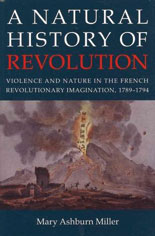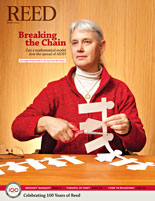
IRIS login | Reed College home Volume 91, No. 1: March 2012
Reediana
A Natural History of Revolution (Cornell University Press, 2011)
Mary Ashburn Miller [history 2008-]
Reviewed by Anna Mann

How did the French revolutionaries explain, justify, and apprehend the extraordinary violence of the Reign of Terror? Mary Ashburn Miller, assistant professor of history and humanities at Reed, suggests that important clues to the French Revolution can be found by looking at eighteenth-century ideas about the natural world, particularly earthquakes, lightning, mountains, swamps, and volcanoes.
Revolutionaries repeatedly deployed these events as metaphors, drawing on notions from the natural science of the day about regeneration, purgation, and balance. After all, the revolution took place against a backdrop of extraordinary scientific ferment. The Austrian physician Franz Mesmer arrived in Paris in 1778, electrifying audiences with his demonstrations of animal magnetism. Although Jean-Paul Marat was best known as a revolutionary leader, he also wrote about electricity and fire. Other revolutionaries were astronomers and engineers.
A conversation with Mary Ashburn Miller
The new scientific ideas had enormous social repercussions. Mesmer, for example, argued that the natural and the social worlds were linked by a magnetic flux. The revolutionaries took this idea to its logical, if frightening, extreme. If thunder and lightning could clear the atmosphere of evil humors, and if volcanic eruptions could create more fertile soil, then episodes of violence, no matter how regrettable, were sometimes necessary to forge a new political order. Pointing to the devastating Lisbon earthquake of 1755, which killed thousands of people but which ultimately led to the city’s rebirth and renewal, the revolutionaries portrayed bloodshed as an inevitable phase that France must undergo before she could be restored to her true destiny.


LATEST COMMENTS
steve-jobs-1976 I knew Steve Jobs when he was on the second floor of Quincy. (Fall...
Utnapishtim - 2 weeks ago
Prof. Mason Drukman [political science 1964–70] This is gold, pure gold. God bless, Prof. Drukman.
puredog - 1 month ago
virginia-davis-1965 Such a good friend & compatriot in the day of Satyricon...
czarchasm - 4 months ago
John Peara Baba 1990 John died of a broken heart from losing his mom and then his...
kodachrome - 7 months ago
Carol Sawyer 1962 Who wrote this obit? I'm writing something about Carol Sawyer...
MsLaurie Pepper - 8 months ago
William W. Wissman MAT 1969 ...and THREE sisters. Sabra, the oldest, Mary, the middle, and...
riclf - 10 months ago